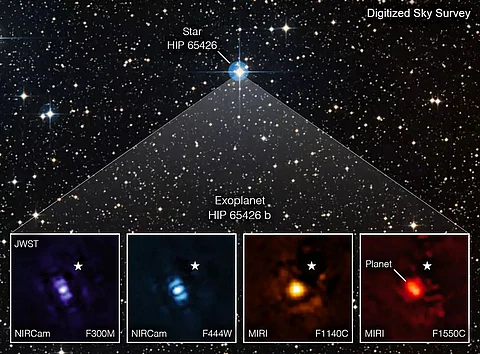
- Home
- Live Blog
- Breaking News
- Top Headlines
- Cities
- NE News
- Sentinel Media
- Sports
- Education
- Jobs

GUWAHATI: For the first time, astronomers have used NASA's James Webb Space Telescope to take a direct image of a planet outside our solar system, said a statement from NASA headquarters at Washington DC.
The exoplanet (the term for a planet outside our solar system) is a gas giant, meaning it has no rocky surface and could not be habitable.
The image, as seen through four different light filters, shows how Webb's powerful infrared gaze can easily capture worlds beyond our solar system, pointing the way to future observations that will reveal more information than ever before about exoplanets.
The James Webb Space Telescope was launched on 25 December 2021 on an Ariane 5 rocket from Kourou, French Guiana, and arrived in January 2022 at the Sun–Earth L2 Lagrange point, where it is deployed in a solar orbit, about 1.5 million kilometers (930,000 mi) from Earth. Webb's Near-Infrared Camera (NIRCam) and Mid-Infrared Instrument (MIRI) are both equipped with coronagraphs, enabling Webb to take direct images of certain exoplanets like this one. Taking direct images of exoplanets is challenging because stars are so much brighter than planets.
"This is a transformative moment, not only for Webb but also for astronomy generally," said Sasha Hinkley, associate professor of physics and astronomy at the University of Exeter in the United Kingdom, who led these observations with a large international collaboration. Webb is an international mission led by NASA in collaboration with its partners, ESA (European Space Agency) and CSA (Canadian Space Agency).
The exoplanet in Webb's image, called HIP 65426 b, is about six to 12 times the mass of Jupiter, and these observations could help narrow that down even further. It is young as planets go — about 15 to 20 million years old, compared to our 4.5-billion-year-old Earth.
Astronomers discovered the planet in 2017 using the SPHERE instrument on the European Southern Observatory's Very Large Telescope in Chile and took images of it using short infrared wavelengths of light. Webb's view, at longer infrared wavelengths, reveals new details that ground-based telescopes would not be able to detect because of the intrinsic infrared glow of Earth's atmosphere.
Webb's first capture of an exoplanet already hints at future possibilities for studying distant worlds.
Also watch: